For many protesters in Hong Kong, identity is entwined with surveillance.
Their signature masks, umbrellas and top-to-bottom black outfits shield them not only from physical threats like the riot police's tear gas and rubber bullets, but also from the invisible dangers of government identification and tracking. Each individual melts into a sea of plastic canopies, their faces obscured, anonymous and united in a shared distrust of the authorities.
Click to Gallery
For many protesters in Hong Kong, identity is entwined with surveillance.
For more than five months, they have led a mass protest movement that prompted Hong Kong's government to withdraw a controversial extradition bill. Following that victory, they have persisted in advocating for their four remaining demands, including calls for democratic reforms and an independent probe into police tactics.
Armed with a portable projector, Dana photographed his subjects on the sidelines of street protests, sometimes with tear gas still thickening the air and clashes mere meters away.
"But after the police started abusing their rights and arresting more people, we decided to protect ourselves (with the masks)," she said. "We are afraid of the (mask) law, but we are still coming out because we need to find hope, to find the future of Hong Kong."
In this Oct. 18, 2019, photo, Wong Ho poses for a portrait next to a barricade as a projector displays a photograph, previously taken during the unrest, over him at a protest in Hong Kong. For more than five months, protesters have led a mass movement that prompted the Hong Kong government to withdraw a controversial extradition bill. Following this victory, they have persisted in advocating for their four remaining demands, including calls for democratic reforms and an independent probe into police tactics. (AP PhotoFelipe Dana)
In this Oct. 16, 2019, photo, a 14-year-old protester who identified herself as K.C., poses for a portrait as a projector displays a photograph, previously taken during the unrest, over her at a protest in Hong Kong. For many protesters, identity is entwined with surveillance. Their signature masks, umbrellas and top-to-bottom black outfits shield them not only from physical threats like the riot police's tear gas and rubber bullets, but also from the invisible dangers of government identification and tracking. (AP PhotoFelipe Dana)
In this Oct. 20, 2019, photo, a protester who identified himself as Tom, poses for a portrait next to a damaged subway station as a projector displays a photograph, previously taken during the unrest, over him at a protest in Hong Kong. Tom said "If we don't wear the mask, the police can recognize you and say you are a rioter and arrest you for no reason, even if you are peacefully protesting. That's the white terror they want to do." (AP PhotoFelipe Dana)
In this Oct. 19, 2019, photo, a protester who identified herself as Cindy, poses for a portrait as a projector displays a photograph, previously taken during the unrest, over her at a protest in Hong Kong. An attempt last month to impose a city-wide mask ban only further inflamed the demonstrators, who now cover up in defiance. "Wearing a mask right now is a statement against the Emergency Law," Cindy said. (AP PhotoFelipe Dana)
In this Oct. 16, 2019, photo, a protester who identified herself as Sonia, poses for a portrait next to a broken glass door as a projector displays a photograph, previously taken during the unrest, over her at a protest in Hong Kong. For many protesters, identity is entwined with surveillance. Their signature masks, umbrellas and top-to-bottom black outfits shield them not only from physical threats like the riot police's tear gas and rubber bullets, but also from the invisible dangers of government identification and tracking. (AP PhotoFelipe Dana)
In smashing, spray-painting and shining lasers on surveillance cameras across the semi-autonomous Chinese territory, the demonstrators say they are fighting back against an omniscient state security apparatus that already envelops mainland China.
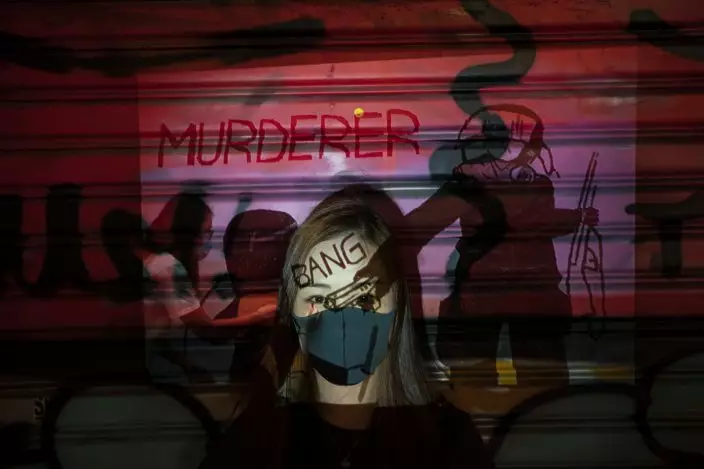
In this Oct. 19, 2019, photo, a 24-year-old protester who identified herself as Kathy, poses for a portrait as a projector displays a photograph, previously taken during the unrest, over her at a protest in Hong Kong. Police have arrested thousands of protesters since June, on charges such as illegal assembly and rioting. An attempt last month to impose a city-wide mask ban only further inflamed the demonstrators, who now cover up in defiance. (AP PhotoFelipe Dana)
For more than five months, they have led a mass protest movement that prompted Hong Kong's government to withdraw a controversial extradition bill. Following that victory, they have persisted in advocating for their four remaining demands, including calls for democratic reforms and an independent probe into police tactics.
Police have arrested more than 3,000 protesters since June, on charges such as illegal assembly and rioting. An attempt last month to impose a city-wide ban on face masks only further inflamed the demonstrators, who now cover up in defiance.
Curious about the young protesters behind these masks, Associated Press photographer Felipe Dana set out to take portraits of them. Because many were afraid to bare their faces to the camera, Dana chose to project on them photos snapped during previous demonstrations, inserting an extra layer between them and his lens.
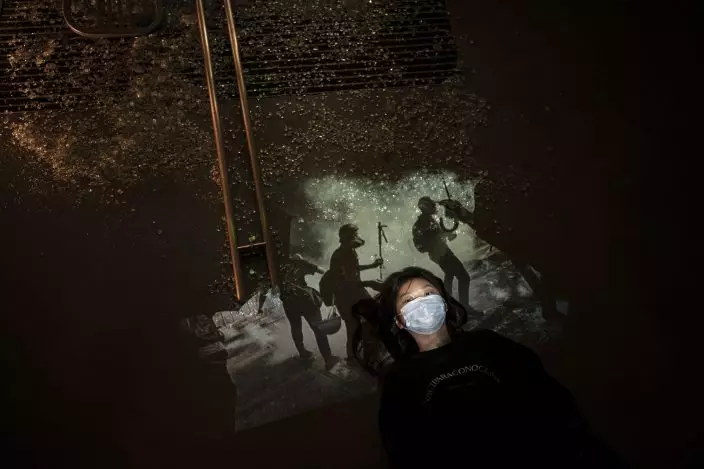
In this Oct. 16, 2019, photo, a protester who identified herself as Morty, poses for a portrait next to pieces of broken glass as a projector displays a photograph, previously taken during the unrest, over her at a protest in Hong Kong. For many protesters, identity is entwined with surveillance. Their signature masks, umbrellas and top-to-bottom black outfits shield them not only from physical threats like the riot police's tear gas and rubber bullets, but also from the invisible dangers of government identification and tracking. (AP PhotoFelipe Dana)
Armed with a portable projector, Dana photographed his subjects on the sidelines of street protests, sometimes with tear gas still thickening the air and clashes mere meters away.
They expressed worry that the ruling Communist Party's watchful eye might be exported abroad via technologies like Huawei smartphones or Tik Tok videos. In China's far western Xinjiang region, a comprehensive surveillance network — complete with facial recognition cameras and phone scanning devices — closely monitors members of Muslim minority groups.
"At the beginning, not everyone wore masks," said Josephine, a 24-year-old who sported a turquoise surgical face mask.
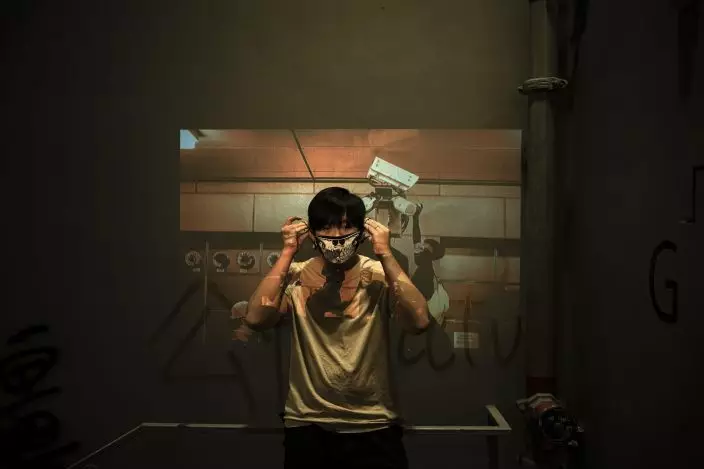
In this Oct. 16, 2019, photo, a protester who identified himself as Jason, poses for a portrait as a projector displays a photograph, previously taken during the unrest, over him at a protest in Hong Kong. In smashing, spray-painting and shining lasers on surveillance cameras across the semi-autonomous Chinese city, these demonstrators say they are fighting back against an omniscient state security apparatus that already envelops mainland China. (AP PhotoFelipe Dana)
"But after the police started abusing their rights and arresting more people, we decided to protect ourselves (with the masks)," she said. "We are afraid of the (mask) law, but we are still coming out because we need to find hope, to find the future of Hong Kong."
Like the other portrait subjects, Josephine asked not to be identified by her full name because she fears government retribution.
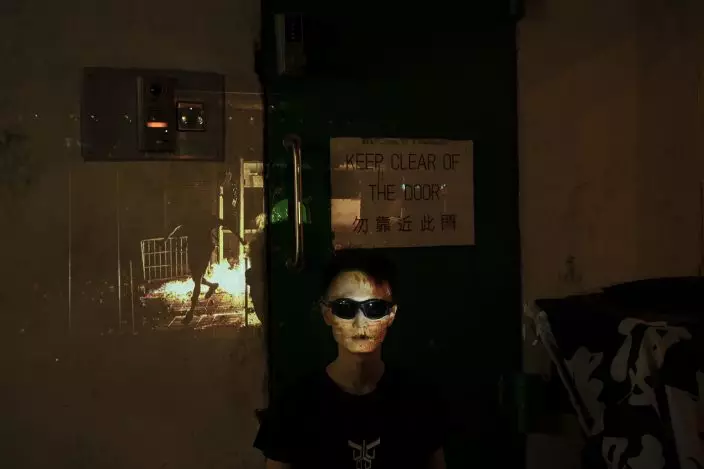
In this Oct. 19, 2019, photo, a protester who identified himself as Eliot, 33, poses for a portrait as a projector displays a photograph, previously taken during the unrest, over him at a protest in Hong Kong. Eliot believes that his role in the protest is to protect the younger demonstrators, "If it's necessary I can be arrested for them" he says. (AP PhotoFelipe Dana)
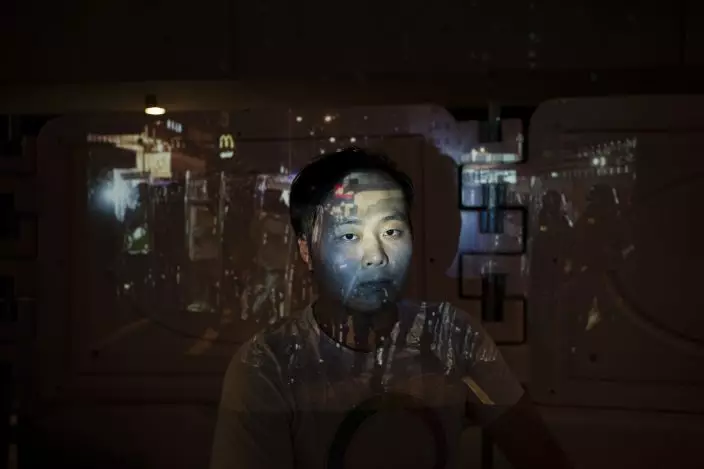
In this Oct. 18, 2019, photo, Wong Ho poses for a portrait next to a barricade as a projector displays a photograph, previously taken during the unrest, over him at a protest in Hong Kong. For more than five months, protesters have led a mass movement that prompted the Hong Kong government to withdraw a controversial extradition bill. Following this victory, they have persisted in advocating for their four remaining demands, including calls for democratic reforms and an independent probe into police tactics. (AP PhotoFelipe Dana)
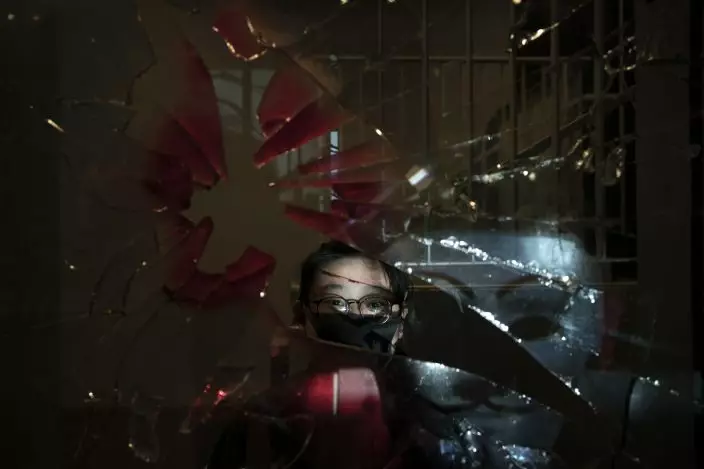
In this Oct. 16, 2019, photo, a 14-year-old protester who identified herself as K.C., poses for a portrait as a projector displays a photograph, previously taken during the unrest, over her at a protest in Hong Kong. For many protesters, identity is entwined with surveillance. Their signature masks, umbrellas and top-to-bottom black outfits shield them not only from physical threats like the riot police's tear gas and rubber bullets, but also from the invisible dangers of government identification and tracking. (AP PhotoFelipe Dana)
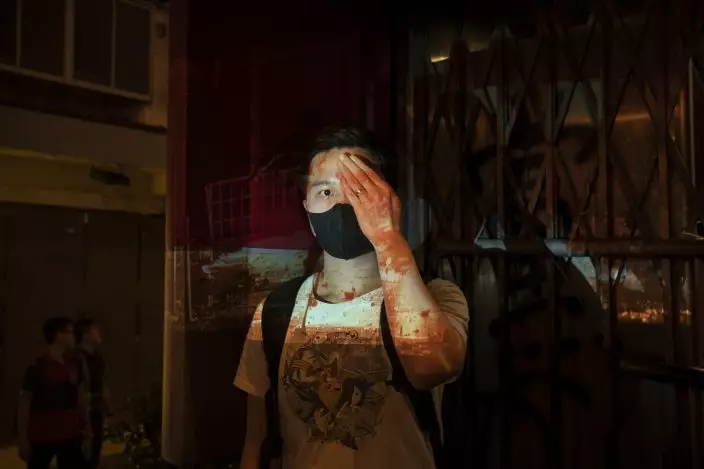
In this Oct. 20, 2019, photo, a protester who identified himself as Tom, poses for a portrait next to a damaged subway station as a projector displays a photograph, previously taken during the unrest, over him at a protest in Hong Kong. Tom said "If we don't wear the mask, the police can recognize you and say you are a rioter and arrest you for no reason, even if you are peacefully protesting. That's the white terror they want to do." (AP PhotoFelipe Dana)
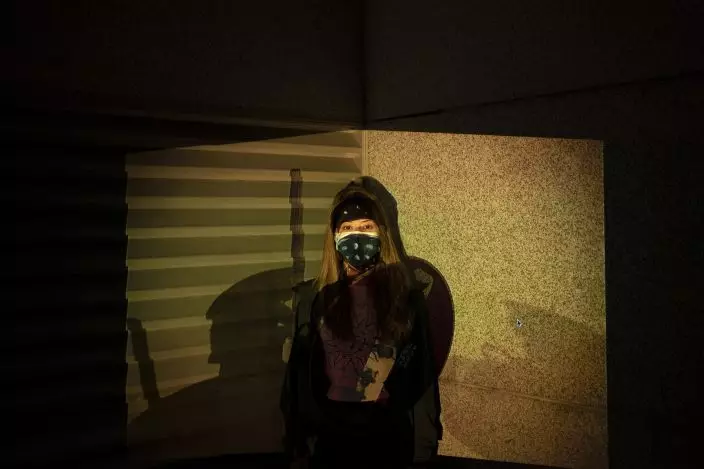
In this Oct. 19, 2019, photo, a protester who identified herself as Cindy, poses for a portrait as a projector displays a photograph, previously taken during the unrest, over her at a protest in Hong Kong. An attempt last month to impose a city-wide mask ban only further inflamed the demonstrators, who now cover up in defiance. "Wearing a mask right now is a statement against the Emergency Law," Cindy said. (AP PhotoFelipe Dana)
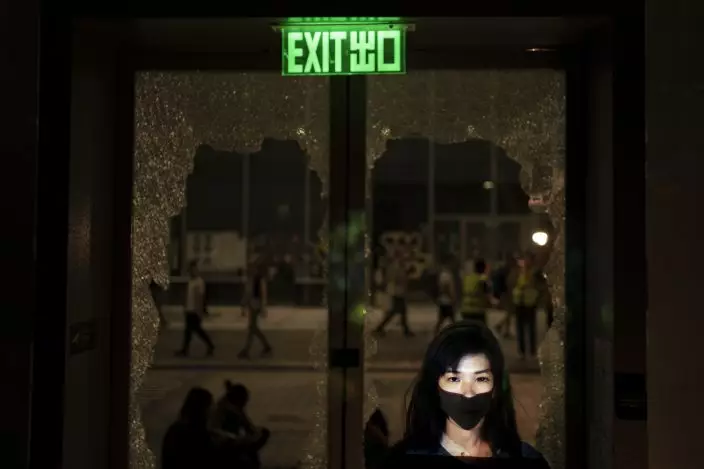
In this Oct. 16, 2019, photo, a protester who identified herself as Sonia, poses for a portrait next to a broken glass door as a projector displays a photograph, previously taken during the unrest, over her at a protest in Hong Kong. For many protesters, identity is entwined with surveillance. Their signature masks, umbrellas and top-to-bottom black outfits shield them not only from physical threats like the riot police's tear gas and rubber bullets, but also from the invisible dangers of government identification and tracking. (AP PhotoFelipe Dana)
DETROIT (AP) — The Oakland Athletics no longer have to wonder where they'll play the next few seasons. That won't make the long goodbye any easier.
The A's reacted to the announcement that this will be their last year in Oakland with a mixture of sadness and relief.
“At least as a player, you know where you’re headed,” outfielder Seth Brown said Friday before a game against the Tigers in Detroit. “There’s obviously a lot of moving parts, a lot of stuff we’re not privy to, so it’s just been kind of a waiting game on our end. Where are we going to go? Where are we going to be? So I think just having that knowledge -- at least we know where we’re going to be playing next year.”
Vivek Ranadivé, who owns the Triple-A Sacramento River Cats, and Oakland Athletics owner John Fisher announced Thursday that the A’s will temporarily relocate to West Sacramento's Sutter Health Park for at least three seasons. The A's are moving to Las Vegas after a new ballpark is constructed.
The River Cats, who are affiliated with the San Francisco Giants, will continue to play at the same facility.
Fisher was unable to reach an agreement with Oakland city officials on extending the lease at Oakland Coliseum, which expires at the end of this season. The A's have played in the city since 1968.
“There's direction now, which we've talked a lot about,” Oakland A's manager Mark Kotsay said. “We've got time to kind of reflect on what this really means from an organizational standpoint, the history that we've had in Oakland, with this being now the final season. There's a lot of emotion that goes behind this.”
It will not only cause some upheaval for the players and staff but also members of the organization that work behind the scenes.
“At the end of the day, we know where we're going to be for the next three seasons after the finish this year and that in itself gives a little bit of stability,” Kotsay said. “At the same time, in the present, it's challenging in certain ways to think about the finality of this organization in Oakland.”
Sacramento will be a much smaller environment to house a major league team. Ranadivé said the River Cats venue currently seats 16,000 when counting the stands, the lawn behind center field and standing room only.
First baseman Ryan Noda is concerned with the facilities. He's hopeful that significant upgrades will be made, much like the Toronto Blue Jays did at Buffalo's Triple-A facility. The Blue Jays played at Buffalo's Sahlen Field in 2020 in 2021 during the COVID-19 pandemic.
“New walls, new dugouts, new locker rooms — everything they needed to become a big league stadium,” said Noda, who played some games in Sacramento as a minor leaguer. “As long as we can do something like that, then it'll be all right. But it's definitely going to be different than playing in stadiums that hold 40,000 people.”
Kotsay is confident the upgrades will occur.
“I know it will be of major league baseball quality,” he said. “It's has to be of major league baseball quality. I know the Players Association will make sure that takes place, as they did in Buffalo.”
For the rest of this season, the A's will have to deal with small home crowds and disappointed fans.
“We’re sad for the fans, the diehard fans, who always come to our games, always support us, always support the boys wearing the jersey,” Noda said.
AP MLB: https://apnews.com/hub/mlb
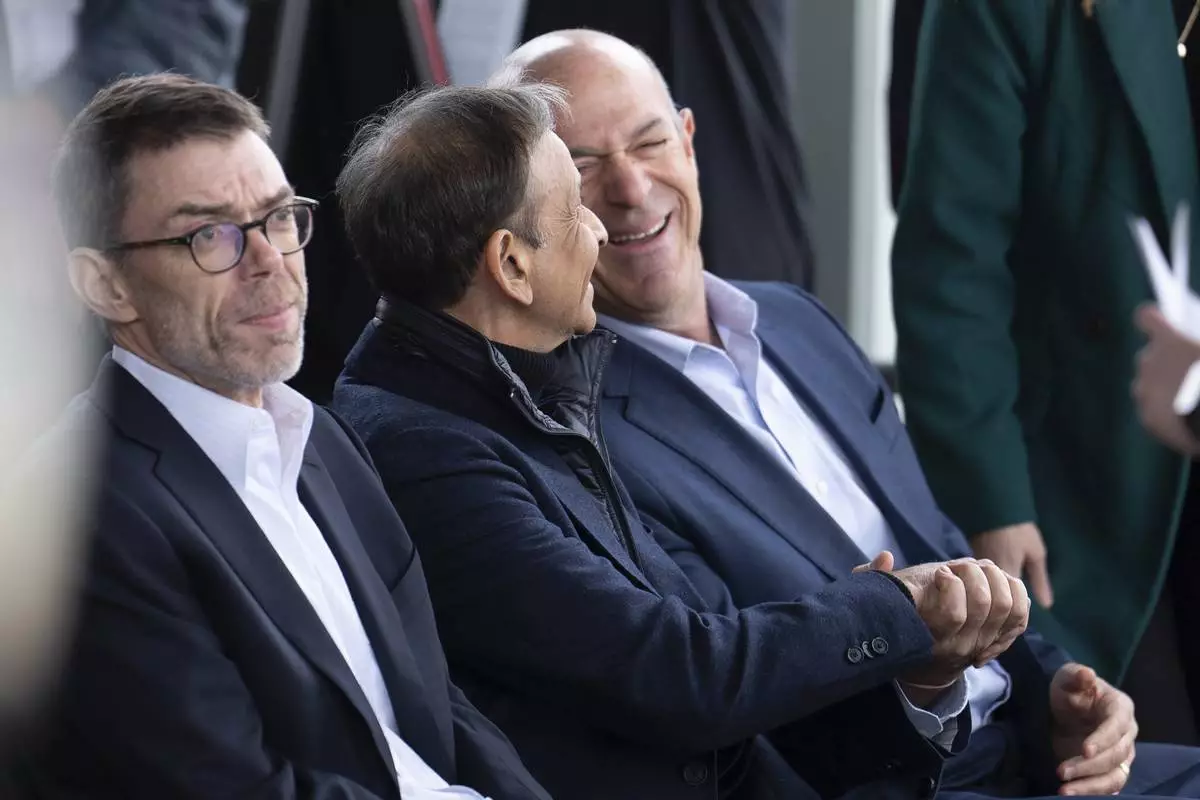
Sacramento Kings owner Vivek Ranadive, center, shakes hands John Fisher, owner of the Oakland Athletics, before the start of a news conference where Fisher announced his team will leave Oakland after this season and play temporarily at a minor league park, during a news conference in West Sacramento, Calif., Thursday, April 4 2024.The A's announced the decision to play at the home of the Sacramento River Cats from 2025-27 with an option for 2028 on Thursday after being unable to reach an agreement to extend their lease in Oakland during that time. (AP Photo/Rich Pedroncelli)

John Fisher, owner of the Oakland Athletics baseball team, announces that his team will leave Oakland after this season and play temporarily at a minor league park, during a news conference in West Sacramento, Calif., Thursday, April 4, 2024. The A's announced the decision to play at the home of the Sacramento River Cats from 2025-27 with an option for 2028 on Thursday after being unable to reach an agreement to extend their lease in Oakland during that time. (AP Photo/Rich Pedroncelli)
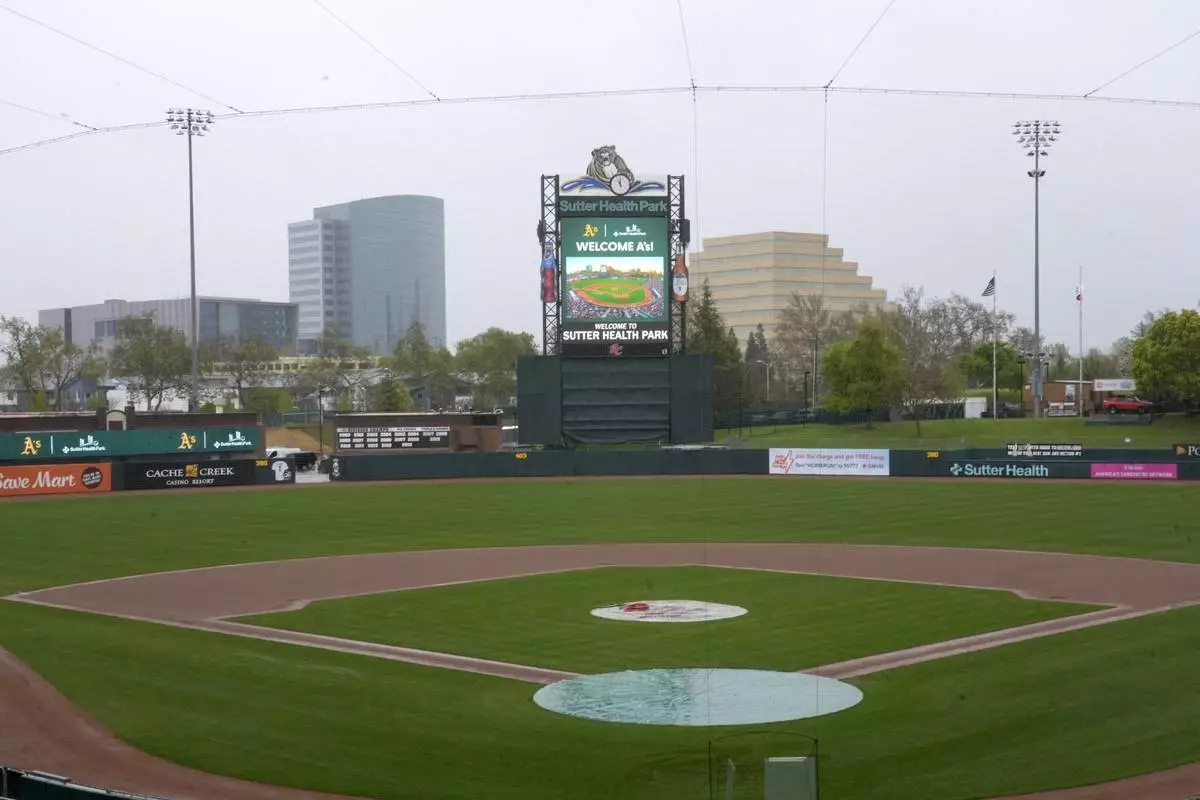
Sutter Health Park, home of the Triple A team Sacramento River Cats, is shown in West Sacramento, Calif., Thursday, April 4, 2024. The Oakland Athletics announced the decision to play at the home of the Sacramento River Cats from 2025-27 with an option for 2028 on Thursday after being unable to reach an agreement to extend their lease in Oakland during that time. (AP Photo/Rich Pedroncelli)
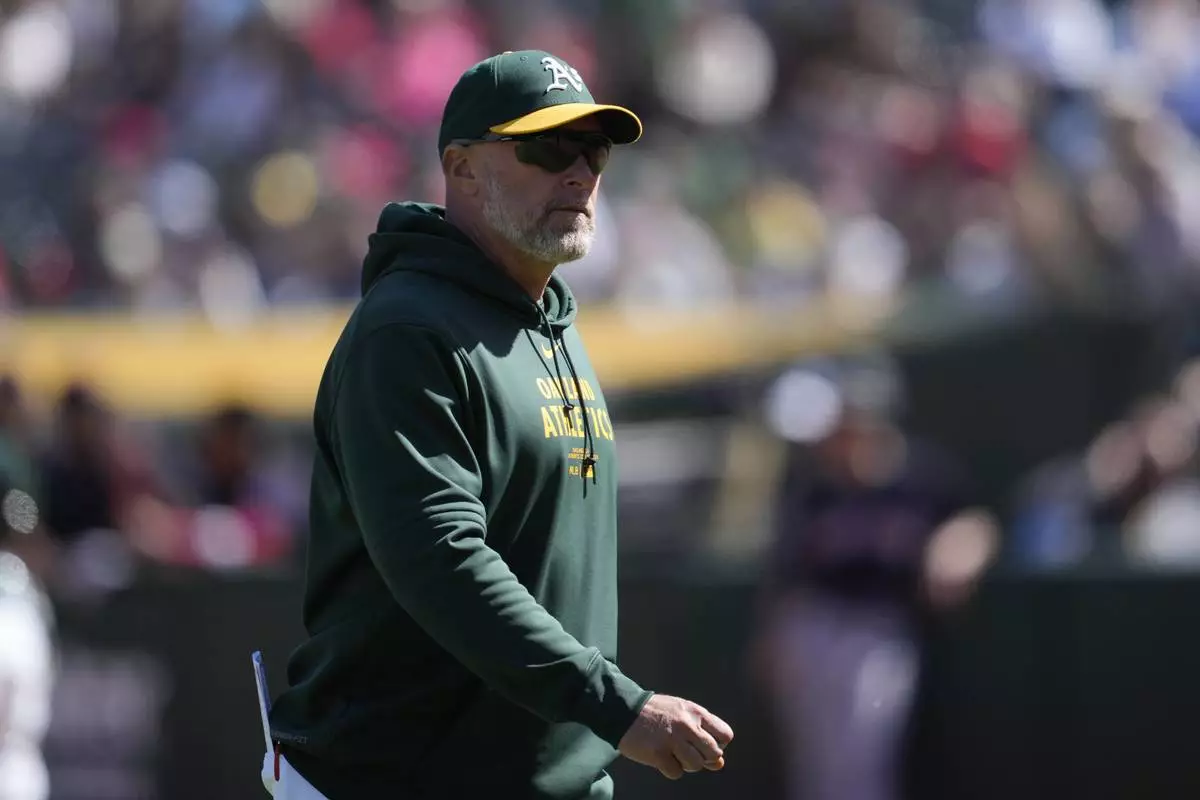
Oakland Athletics manager Mark Kotsay walks to the dugout after making a pitching change during the eighth inning of the team's baseball game against the Cleveland Guardians in Oakland, Calif., Sunday, March 31, 2024. (AP Photo/Jeff Chiu)















